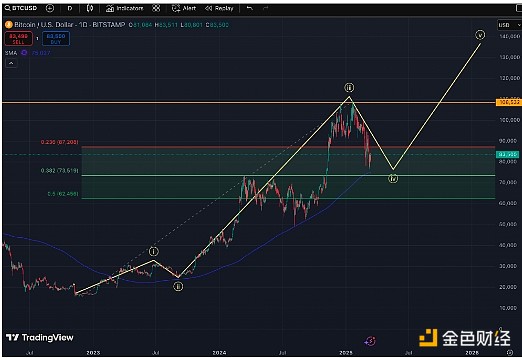Author: Ben Strack, Block; Translator: Baishui, Golden Finance
For some time, I have been getting technical analysis of Bitcoin prices from John Glover, CIO of Ledn, via email.
But I was finally able to meet him in person at the Digital Asset Summit.
Glover, who previously served as managing director at TD Securities and Barclays, uses the Elliott Wave Principle (the study of price patterns associated with changes in investor sentiment and psychology) to predict BTC prices.
Essentially, the theory goes like this:A highly liquid market will move in the direction of the main trend in five waves (three "motivation" phases that drive prices up, with two downward "correction" phases in between). Then there are three waves that go against that trend.
Traders sometimes use this theory in conjunction with other technical analysis to identify possible entry and exit points.
According to Glover, last week, we may have approached the end of the fourth wave (downtrend) in this broader BTC price uptrend, which began in 2023 at around $16,000. He noted that the market was not impressed by Donald Trump's pro-cryptocurrency remarks at last week's conference.

BTC performance since January 2023. Source: TradingView.
Whether or not the fourth wave is officially over, Glover expects the fifth wave to lead BTC prices to between $130,000 and $135,000 in the first quarter of 2026.
Beyond specific price levels, I asked Glover how people view Bitcoin — a safe haven for some, a risk-on asset for others.
“Even though we have deep liquidity, there aren’t enough participants [in Bitcoin] who have fully understood what it is and formed that view,” he said.
Those who believe BTC is “digital gold” (and an inflation hedge) may add to their Bitcoin ETF positions as prices fall. Those who worry that BTC’s rise to around $109,000 is just the result of a “Trump pump” may panic and exit.
“To me, [bitcoin] is digital gold, and once more traditional financial players come on board, it will start to track gold more closely,” Glover added.
Nearly one-fifth of financial advisors surveyed who don’t allocate crypto to clients plan to increase that exposure by 2025 (more than double the 8% who did the year before). But those who haven’t yet committed may want to see BTC rise again before they do, Glover said.
These tend to be trickier positions.
“If people have it in their portfolio, I don’t think they’re going to panic if the price pulls back,” Glover said. “I think they’ll say, ‘Well, it’s only 1% of my portfolio and I’m happy to hold it for the long term.’”
 YouQuan
YouQuan







